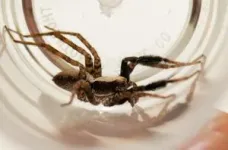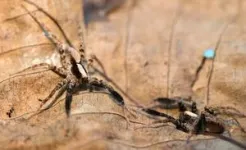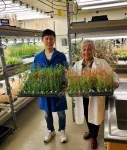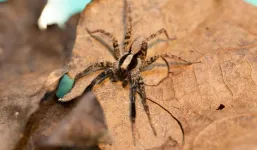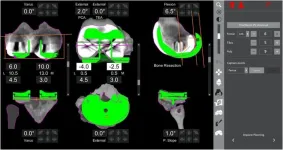(Press-News.org) Imagine journeying back in time to the era of woolly mammoths, some 14,000 years ago. That’s what a team of international researchers from the University of Ottawa, the University of Alaska Fairbanks, McMaster University and Adelphi University, and Indigenous scholars, managed to do. Using novel high-resolution isotope profiling (a sort of “paleo-GPS”), they were able to connect the dots between the wanderings of a woolly mammoth and the earliest known human settlements in the remote expanses of eastern Beringia (the land and maritime area between the Lena River in Russia and Canada’s Mackenzie River).
The paper, published in Science Advances, sheds light on the relationship between mammoths and early hunter-gatherer communities in the region. Through a detailed analysis of the mammoth’s remains and genetic connections, the researchers were able to reconstruct the life history and movements of this iconic species, providing evidence of overlapping mammoth/human habitats and of the possible role mammoths played in facilitating the peopling of the Americas.
This study focuses on a female woolly mammoth, “Élmayuujey’eh” (Elma), named by the Healy Lake (Alaska) Village Council, whose remains were discovered at Swan Point, the earliest archeological site in Alaska. Alongside the mammoth, the site also contained remains of a juvenile and a baby mammoth, indicating the presence of a herd in the area. This finding intrigued researchers and prompted further investigations into the movements and interactions between mammoths and early humans.
Clément Bataille (associate professor, Department of Earth and Environmental Sciences, Faculty of Science, University of Ottawa), lead author and PhD student Audrey Rowe (University of Alaska Fairbanks) and co-author Matthew Wooller (University of Alaska Fairbanks) conducted a detailed isotopic analysis of Élmayuujey’eh’s complete tusk. This allowed them to retrace the mammoth’s movements through her lifetime.
“Elma roamed extensively within the densest region of archaeological sites in Alaska,” says Rowe. “This suggests a close association between mammoths and early human hunting camps.”
Meanwhile, Hendrik Poinar and his team at McMaster University conducted genetic analyses of the remains of eight other individual mammoths found in the region. They determined that the Swan Point area likely served as a meeting ground for at least two closely related herds. This suggests that mammoths had social structures and exhibited herd behavior.
Solving the mystery of human-mammoth coexistence
“This research gives new insights into how humans and mammoths interacted when humans first came to the Americas,” says Bataille. “It seems that mammoths, which were plentiful in eastern Beringia and an important food source, attracted humans to the area.”
It’s not the first time that this geolocation technique has been used to retrace the mobility of a mammoth. The team created it for a study of a 17,000 year old male named Kik, who lived in a colder period when humans hadn’t yet arrived, unlike Elma.
Interestingly, Kik and Elma showed very different mobility behaviours. Kik moved freely over long distances across large valleys and tundra plains using regular core areas, whereas Elma, while still using similar core areas, moved shorter distances, maintaining a high elevation. This raises questions about the role of humans and climate change in influencing the mobility of this ancient species.
This high-resolution isotope profiling technique can be applied to uncover the ecology of many other extinct species. Used with genetic analysis, it’s an innovative way to learn about how ancient species responded to climate change and human pressures, and what ultimately caused their extinction.
By shedding light on mammoth ecology and lifeways and mammoths’ long-term interactions with climate change and humans, the study can help us predict how animals will respond to climate and human pressures in the future. “The new tools developed in this research, along with the insights into the ecology of extinct species, will help with efforts to conserve biodiversity, providing an analogue to modern times, where many large mammals are in danger of going extinct with human and climate perturbations,” says Bataille.
This study was funded in part by the NSERC Discovery Grants program and was published in Science Advances on January 17.
END
Researchers make links between woolly mammoths and colonization of the Americas
uOttawa professor and team go back 14,000 years to show links between mammoths and early hunter-gatherer communities
2024-01-17
ELSE PRESS RELEASES FROM THIS DATE:
Governor Hochul announces CUNY to receive $75 million from the Simons Foundation, largest donation in university history
2024-01-17
Governor Kathy Hochul today announced that the City University of New York is receiving $75 million from the Simons Foundation, the University’s largest-ever donation. The gift earmarks $50 million to establish CUNY as a hub for computational science and $25 million to support CUNY’s participation in the Governor’s proposed Empire AI project. Computational science uses programming techniques to solve problems in fields such as biology, astrophysics and neuroscience.
“For many New Yorkers, higher education is critical to pursuing a career ...
Keys to aging hidden in the leaves
2024-01-17
Scientists have known about a particular organelle in plant cells for over a century. However, UC Riverside scientists have only now discovered that organelle’s key role in aging.
The researchers initially set out to understand more generally which parts of plant cells control plant responses to stress from things like infections, too much salt, or too little light. Serendipitously, they found this organelle, and a protein responsible for maintaining the organelle, control whether plants survive being left too often in the dark.
Because they had not expected this discovery, which is ...
Rain can spoil a wolf spider’s day, too
2024-01-17
If you hate the rain, you have something in common with wolf spiders.
Researchers at the University of Cincinnati found that wolf spiders can’t signal others or perceive danger from predators as easily on rain-soaked leaves compared to dry ones. Even communicating with would-be mates is harder after it rains.
The study was published in the Journal of Insect Behavior.
Biologists in UC’s College of Arts and Sciences studied Schizocosa ocreata, a wolf spider found across much of the United States. Males respond to chemical signals from females by using a combination of visual ...
Independent dispute resolution of no surprises act financially unviable for radiology
2024-01-17
Leesburg, VA, January 17, 2024—According to the American Journal of Roentgenology (AJR), the No Surprises Act’s (NSA) independent dispute resolution (IDR) process would be financially unfeasible for a large portion of out-of-network (OON) claims for hospital-based specialties—more so for radiologists than other specialists.
“Although the NSA enacted important patient protections, IDR fees limit clinicians’ opportunities to dispute payer-determined payments and potentially undermine their bargaining power in contract negotiations,” ...
AMS presidential forum to address “Climate Science as Service to Society”
2024-01-17
[Boston, MA—January 17, 2024] The American Meteorological Society (AMS) will open its 104th Annual Meeting with a Presidential Forum on how to advance society’s acceptance and use of climate science. Distinguished atmospheric scientist Dr. Kerry Emanuel will moderate a “fireside chat” with Monica Medina, President and CEO of the Wildlife Conservation Society and former Deputy Assistant Secretary at the State Department, and Bob Inglis, Executive Director of RepublicEn.org and former congressman from South Carolina. The Forum, with opening remarks by AMS President ...
Researchers find anti-HIV drugs may prevent complications from bacterial sepsis
2024-01-17
Bacterial infections can lead to the formation of abscesses — pockets of dead cells and debris surrounded by inflammatory immune cells. Bacteria multiply within abscesses, causing more inflammation and further damage to surrounding tissues. In severe cases, these immune reactions spread across the body, resulting in life-threatening organ failure, or sepsis. But how these abscesses form and what can be done to prevent them were previously not well understood.
Using preclinical models, investigators from Brigham and ...
The heat is on: UMass Amherst scientists discover southern Africa’s temps will rise past the rhinos’ tolerance
2024-01-17
January 17, 2024
The Heat is on: UMass Amherst Scientists Discover Southern Africa’s Temps Will Rise Past the Rhinos’ Tolerance
New research shows that rising temperatures caused by climate change are impacting the remaining black and white rhinoceros populations on the African continent, suggests taking steps to mitigate impact now
AMHERST, Mass. – Southern Africa contains the vast majority of the world’s remaining populations of both black and white rhinoceroses ...
Next generation spinal fusion goes "meta"
2024-01-17
A civil engineer at the University of Pittsburgh is applying his expertise in bridges and infrastructure to develop new materials that better treat spinal injury, repair, and recovery. Amir Alavi’s proposal received a $557,000 boost from the National Institutes of Health to test the first “metamaterial” orthopedic implants.
With an estimated 342,000 procedures per year in the U.S.1, interbody spinal fusion is a popular procedure to treat a range of spinal pain and injuries, from herniated discs and degenerative diseases to trauma. Interbody fusion cages are spinal implants that are used in most of ...
Study identifies new findings on implant positioning and stability during robotic-assisted knee revision surgery
2024-01-17
HUNTINGTON, W.Va. - An innovative study at Marshall University published in ArthroplastyToday explores the use of robotic-assisted joint replacement in revision knee scenarios, comparing the pre- and post-revision implant positions in a series of revision total knee arthroplasties (TKA) using a state-of-the-art robotic arm system.
In this retrospective study, the orthopaedic team at the Marshall University Joan C. Edwards School of Medicine and Marshall Health performed 25 revision knee replacements with a robotic assisted computer system. The procedure involved placing new implants at the end of the thighbone and top of the shinbone with the computer's aid to ensure ...
New vaccine design uses immunity against influenza to offer faster protection against emerging pathogens
2024-01-17
RIVERSIDE, Calif. -- After COVID vaccination, it usually takes weeks for our bodies to develop protective antibody responses. Imagine, however, a vaccine that speeds up the production of antibodies against SARS-CoV-2, the virus that spreads COVID-19.
A research team led by Rong Hai, an associate professor of microbiology and plant pathology at the University of California, Riverside, has developed such a vaccine by using preexisting immunity to a separate virus (the influenza virus) to help kickstart the process of making antibodies ...
LAST 30 PRESS RELEASES:
Decoupling the HOR enhancement on PtRu: Dynamically matching interfacial water to reaction coordinates
Sulfur isn’t poisonous when it synergistically acts with phosphine in olefins hydroformylation
URI researchers uncover molecular mechanisms behind speciation in corals
Chitin based carbon aerogel offers a cleaner way to store thermal energy
Tracing hidden sources of nitrate pollution in rapidly changing rural urban landscapes
Viruses on plastic pollution may quietly accelerate the spread of antibiotic resistance
Three UH Rainbow Babies & Children’s faculty elected to prestigious American Pediatric Society
Tunnel resilience models unveiled to aid post-earthquake recovery
Satellite communication systems: the future of 5G/6G connectivity
Space computing power networks: a new frontier for satellite technologies
Experiments advance potential of protein that makes hydrogen sulfide as a therapeutic target for Alzheimer’s disease
Examining private equity’s role in fertility care
Current Molecular Pharmacology achieves a landmark: real-time CiteScore advances to 7.2
Skeletal muscle epigenetic clocks developed using postmortem tissue from an Asian population
Estimating unemployment rates with social media data
Climate policies can backfire by eroding “green” values, study finds
Too much screen time too soon? A*STAR study links infant screen exposure to brain changes and teen anxiety
Global psychiatry mourns Professor Dan Stein, visionary who transformed mental health science across Africa and beyond
KIST develops eco-friendly palladium recovery technology to safeguard resource security
Statins significantly reduce mortality risk for adults with diabetes, regardless of cardiovascular risk
Brain immune cells may drive more damage in females than males with Alzheimer’s
Evidence-based recommendations empower clinicians to manage epilepsy in pregnancy
Fungus turns bark beetles’ defenses against them
There are new antivirals being tested for herpesviruses. Scientists now know how they work
CDI scientist, colleagues author review of global burden of fungus Candida auris
How does stroke influence speech comprehension?
B cells transiently unlock their plasticity, risking lymphoma development
Advanced AI dodel predicts spoken language outcomes in deaf children after cochlear implants
Multimodal imaging-based cerebral blood flow prediction model development in simulated microgravity
Accelerated streaming subgraph matching framework is faster, more robust, and scalable
[Press-News.org] Researchers make links between woolly mammoths and colonization of the AmericasuOttawa professor and team go back 14,000 years to show links between mammoths and early hunter-gatherer communities

